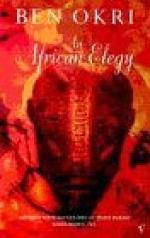|
This section contains 400 words (approx. 1 page at 400 words per page) |

|
An African Elegy Summary & Study Guide Description
An African Elegy Summary & Study Guide includes comprehensive information and analysis to help you understand the book. This study guide contains the following sections:
This detailed literature summary also contains Bibliography on An African Elegy by Robert Duncan.
"An African Elegy" is one of the most controversial poems that Duncan ever wrote. Editor John Crowe Ransom accepted the poem for publication in The Kenyon Review in 1942 calling it "very brilliant." However, after Duncan published his essay "The Homosexual in Society" in Dwight Mac- Donald's radical monthly Politics, "outing" himself and arguing (in part) that gay culture needed to see itself as more fully a part of mainstream society, Ransom changed his mind and decided not to publish the poem. Ransom wrote: "We are not in the market for literature of this type." By literature of this type, Ransom meant poetry that, in his view, was an "obvious homosexual advertisement." The curious thing about Ransom's rejection of the poem is that he did not read any homosexual content in it when he accepted it, but only after reading Duncan's essay. Ransom, though he praised the essay, disagreed with it and considered homosexuality an "abnormality." In response to Ransom's new reading of "An African Elegy," Duncan wrote, "The theme of the poem is not homosexuality; nor does the darkness stand for homosexuality. The dark continent in the poem is not what one hides, but what is hidden from one.... It would be rather astounding in an overt homosexual that what was held back, imprisoned in the unconscious, was the homosexual desire." Duncan wanted Ransom to publish their correspondence about the poem in The Kenyon Review, but Ransom refused. The poem was eventually published in 1959.
The poem itself is difficult. Written in eight free-verse stanzas, it is full of symbols and allusions to both Africa and Western literature. The central symbolic metaphor is how the dark jungles of Africa are like the dark and unknown places of the human mind and heart. Duncan loads the poem with African animal imagery and references to famous women (both real women and literary characters), such as Virginia Woolf, Ophelia, and Desdemona, who either committed suicide or were murdered. Death, personified as a "dog-headed man," appears everywhere in the poem, eliciting varying responses from the speaker.
Duncan said that the poem was, in part, inspired by Spanish poet Frederico Garcia Lorca's poem "El Rey de Harlem" (The King of Harlem). Lorca was a heavily persecuted gay writer whom Duncan admired. Even practiced readers of modern poetry, however, would be hard-pressed to find any evidence of a homosexual theme or imagery in the poem.
Read more from the Study Guide
|
This section contains 400 words (approx. 1 page at 400 words per page) |

|



